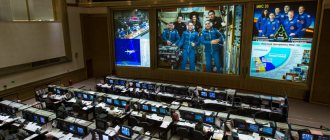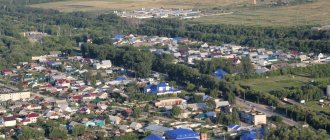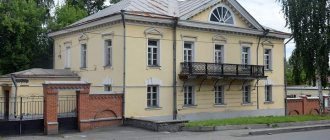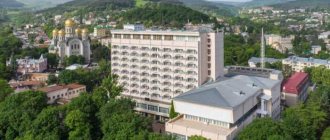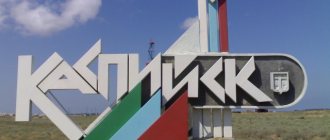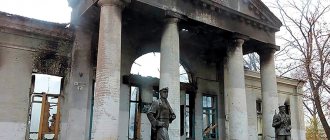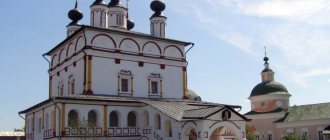Dmitrov is one of the most beautiful cities in the Moscow region: the hills of the Klinsko-Dmitrovskaya ridge, the Moscow canal, the ancient Kremlin, temples and monasteries, ancient houses and estates... In this small guide, compiled on the basis of our own numerous trips to Dmitrov and the Dmitrovsky district (now Dmitrovsky city district), I will try to talk about what, in my opinion, deserves attention here.
Dmitrov Kremlin and monument to Yuri Dolgoruky
Dmitrov's story
People have long settled in these areas, as evidenced by numerous mounds, fortifications and sanctuaries. Dmitrov is not much younger than Moscow - Prince Yuri Dolgoruky founded it in 1154 on the site of an ancient Slavic settlement and named the city in honor of his son Vsevolod (baptized Dmitry) who was born that year. The location was chosen well: near the Yakhroma River, from where the trade route to the Volga went along Sestra and Dubna. Another, land route went to Klyazma, and from there to Vladimir.
In the 12th century, impenetrable forests and swamps began immediately behind Dmitrov. The city served as a northwestern outpost of the Vladimir-Suzdal principality and occupied an important strategic position, covering the road to Suzdal along the Vela and Dubna rivers.
Coat of arms of the city of Dmitrov
Dmitrov was ruined more than once - both by the Mongol-Tatars and by the appanage princes and relatives. To stop the civil strife, the Dmitrov Congress of Princes was convened here in 1301, which was attended by Grand Duke Andrei Alexandrovich of Vladimir (son of Alexander Nevsky), Prince of Tver Mikhail Yaroslavich (nephew of Alexander Nevsky), Prince of Moscow Daniil Alexandrovich (youngest son of Alexander Nevsky), Pereslavsky Prince Ivan Dmitrievich (grandson of Alexander Nevsky). However, the truce did not last long, and four years later the princes resumed the showdown.
The Dmitrov Congress of Princes was reflected in the city’s coat of arms, which Dmitrov received in 1781:
At the top of the shield is the Moscow coat of arms. At the bottom there are four Princely crowns, in an ermine field, in memory of the famous Four Russian Princes Congress that was held in that city.
— The Highest Decree of Empress Catherine II of December 20, 1781
In 1364, the Dmitrov Principality was annexed to Moscow. From that time on, it belonged to one of the younger brothers of the Moscow princes, who bore the title of princes of Dmitrov. The first prince who lived and died here was Peter (1389-1428), one of the younger sons of Dmitry Donskoy. At the end of the 14th – beginning of the 15th century, during the period of civil strife between Dmitry Shemyaka and Vasily Kosy with the Moscow prince Vasily II the Dark, the city repeatedly changed hands. The last prince of Dmitrov was Yuri, the second son of Ivan III.
Under Prince Yuri (ruled 1505-1533), Dmitrov reached his greatest prosperity. The Assumption Cathedral was erected in the Kremlin, and the Boris and Gleb Monastery was rebuilt in stone. An important trade route to the north ran from Moscow through Dmitrov, and the city grew rich.
Apollinary Vasnetsov. "Dmitrov in the 16th century"
In 1556, Ivan the Terrible exchanged Dmitrov for Staritsa from Prince Vladimir Andreevich Staritsky. After the execution of the latter in 1569, Dmitrov finally went to Moscow. The oprichnina almost completely devastated the city.
In January 1610, the troops of Jan Sapieha, who had retreated from the walls of the Trinity-Sergius Monastery, gained a foothold in Dmitrov. The ancient wooden Kremlin was burned, the city was depopulated. After the Time of Troubles, Dmitrov never achieved its previous level of prosperity, turning into a quiet merchant and craft town. In 1781 it received the status of a district town of the Moscow province, and in 1784 it received a regular development plan. The revival of trade contributed to the prosperity of the Dmitrov merchants. In the picturesque Dmitrovsky district, estates of the richest families in Russia are being built.
“Projected” plan of the city of Dmitrov in 1784 from the “Complete Collection of Laws of the Russian Empire. Book of drawings and drawings. City plans"
In September 1812, when Napoleon occupied Moscow, a French detachment settled in Dmitrov. However, having learned about the approach of the Russian army from Klin, he hastily left it.
After the construction of the Nikolaevskaya railway, which passed through Klin, and the Yaroslavl railway through Sergiev Posad, Dmitrov found himself somewhat aloof from traffic flows. River trade, which fed the city in the past, had by that time lost its relevance. In 1900, the Savelovskaya Railway passed through Dmitrov, thanks to which the city received a new impetus for development.
On August 11, 1918, in Dmitrovsky district there was an uprising of local residents against the additional seizure of food, which was brutally suppressed. The instigators were shot on Cathedral Square in Rogachevo. The ashes of the dead Red Army soldiers were transported to Dmitrov and buried in the park on Zagorskaya Street.
In 1932, construction of the Moscow-Volga Canal . The canal was built by prisoners from Dmitlag (a division of the Gulag) and civilians. The leadership of Dmitlag was located in the Dmitrov Boris and Gleb Monastery. Prisoner barracks stood along the entire length of the canal; The names of that time have survived to this day: 3rd section, 4th section, Pace, Competition and others. The canal and hydraulic structures were built almost by hand, without the use of special equipment. The section between Iksha and Dmitrov, which crosses the Klinsko-Dmitrovskaya ridge, turned out to be one of the most difficult, with a large number of locks concentrated here.
Excavation and transportation of soil, photo from the site www.moidmitrov.ru
The total number of Canal Army soldiers killed is still unknown; figures range from 0.7 to 1.5 million people. Nowadays, during construction along the canal, unmarked mass graves are often found. In 1937, many Dmitlag leaders, civilians and former prisoners were shot.
On April 17, 1937, the canal began to be filled with water. On May 1, the first flotilla of Volga ships arrived in Dmitrov. On July 15, permanent navigation began along the Moscow-Volga Canal.
Moscow Canal in Dmitrov
In November 1941, fascist German troops managed to break through the canal and gain a foothold on the dominant Peremilov heights near Dmitrov, from where they were driven out during fierce battles on November 29 - December 5. From here the counter-offensive of the Red Army began. In memory of those events, a memorial was created in 1966 at Peremilov Heights. To stop the enemy's advance, the canal's spillways were opened by December 1, 1941. A huge territory from Yakhroma to the Ivankovo Reservoir went under cold water, thereby stopping the enemy’s advance in this direction.
♦ On the subject: Wall of water: the Moscow Canal during the war
Memorial "Peremilovskaya Heights"
After the war, construction in Dmitrov continued. Over time, old attractions were restored and new ones appeared. And today Dmitrov has turned into one of the most comfortable cities in the Moscow region.
Monument to the holy noble princes Boris and Gleb near the Boris and Gleb Monastery
KREMLIN NAD YAKHROMA
The Dmitrov Kremlin is the historical center of the city, in the past it was a serious defensive structure with a rampart, a wall, towers, surrounded by a moat with drawbridges.
The most important role in the history of Dmitrov was played by its location on the banks of the Yakhroma, which flows into the Sestra River, the Sestra into the Dubna, and the Dubna into the Volga. It turns out that the city was connected by water with the lands of Ancient Rus': Tver, Nizhny Novgorod...
Dmitrov was the closest river pier in Moscow. From Moscow the road to it was “overland”; from Dmitrov the “water passage” to the Volga began - the most important trade route connecting Moscow with the north and partly with the west.
Currently, Dmitrov is located on the Moscow Canal, it is a large, exclusively cargo port: motor ships and passenger ships do not stop in the city. The transport importance of the city is also increasing due to the fact that Dmitrov is located on the Moscow-Savelovo railway of local importance.
The city has preserved several fairly large enterprises - metalworking, construction and light industry. Among the latter is the one located in the village of Verbilki, founded as the first private factory of the Russified English merchant Franz Gardner in 1766, famous throughout the world for the high quality of porcelain, order services and numerous small sculptures. Gardner porcelain became the standard for other private Russian factories.
The historical core of the city is the fortress of the Dmitrov Kremlin. It was unique: unlike other ancient Russian fortresses, it was erected not on a natural hill, but at the foot of the mountain, in a swampy lowland, on stilts - for protection from groundwater. The swamp on the northern side served as a natural defense for the city, just like the arm of the old Yakhroma. The remains of the fort, a 15-meter rampart and a ditch have survived to this day.
The main building of the Kremlin is the Assumption Cathedral, built at the expense of Prince Yuri Ivanovich of Dmitrov, remodeled many times and currently crowned with nine domes. Outside, it is decorated with three monumental tiled bas-reliefs, unique for ancient Russian architecture, with the composition “The Crucifixion” and the image of St. George on a horse. The model for the Assumption Cathedral was the Archangel Cathedral in the Moscow Kremlin.
The prison Elizabethan Church is very unique. Since it was intended for prisoners, the metal patterned window frames were replaced with bars, and inside, along the walls, at the level of the second tier, there was a balcony for the convoy.
On an ancient street in the center of the city stands the Kazan Church: during its existence it was always open and never closed, even during the period of the most severe Bolshevik persecution of the church. The two main attractions of the temple are the miraculous Kazan Icon and the rare chapel of the Beheading of John the Baptist in Orthodox Russia.
The Dmitrov Kremlin Museum-Reserve is one of the oldest and largest museums in the Moscow region. It was founded as a local history museum in 1918 with the participation of the anarchist revolutionary and historian Peter Kropotkin (1842-1921). Initially, the museum was located on the territory of the Boris and Gleb Monastery; in 2002 it moved to a new exhibition center, which is visited by about 60 thousand people a year.
Sights of Dmitrov
The main attractions of Dmitrov can be seen in one day. I love to come here from time to time to enjoy the calm atmosphere of the ancient city near Moscow.
Dmitrov Kremlin
The Dmitrov Kremlin, ovoid in plan, is surrounded by ramparts and a moat. The total length of the ramparts, built in the 12th-13th centuries, is 990 meters, and their height is 7-9 meters, in some places reaching 15 meters. Wooden fortifications - walls and towers - perished during the Time of Troubles. Nowadays, the wooden Nikolsky Gate has been reconstructed.
In 1509-1523, under Prince Yuri Ivanovich of Dmitrov, the Assumption Cathedral . In 1841, porches in a pseudo-Gothic style were added to it. On the north side of the cathedral there is a monument to Cyril and Methodius.
On the territory of the Dmitrov Kremlin there is a prison Elizabethan Church in pseudo-Russian style, built in 1898 by Moscow architect S.K. Rodionov, as well as various administrative buildings built in the 1810s-1830s, a gymnasium, a noble assembly and a parochial school.
Assumption Cathedral and the gymnasium building
Interior decoration of the Assumption Cathedral
Elizabeth Church, Assumption Cathedral, government buildings and outbuildings
Museum-Reserve "Dmitrov Kremlin"
The museum buildings housing the exhibitions of the Dmitrov Kremlin Museum-Reserve are located both on the territory of the Kremlin and next to it. It includes the following objects:
- Museum and exhibition complex . Exhibitions on the history of Dmitrov from the 18th century to the present day, ethnographic collections, exhibition halls. Address: Zagorskaya st., 17.
- Assembly of the Nobility , building built in 1877-1888. The exhibition includes Orthodox church art, works of secular art (mainly from the Olgovo estate), an art gallery, and the “New Arrivals” exhibition. Address: Dmitrov Kremlin.
- Ensemble of public places : treasury, prison and prison outbuildings. The exhibition, located in the Treasury, introduces the history of the Dmitrov region from ancient times to the beginning of the 18th century. Address: Dmitrov Kremlin.
- Museum living room . Venue for concerts, theme nights and other programs. Address: Dmitrov Kremlin.
- House-Museum of P.A. Kropotkin . A small wooden house was built in 1896-1898 for the district leader of the Dmitrov nobility, Count M.A. Olsufiev. The scientist and anarchist theorist Prince Pyotr Alekseevich Kropotkin lived here from 1918 to 1921, and here he died. Address: Kropotkinskaya st., 95.
- House-Museum of the Hieromartyr Seraphim Zvezdinsky, Bishop of Dmitrov . Located on the territory of the former Podlipichye estate, where Bishop Seraphim (Zvezdinsky) of Dmitrov lived from 1920 to 1922. The exhibition “You are all in my heart” presents authentic items from the late 19th – early 20th centuries from the museum’s collections, materials telling about the persecution of the church in Soviet times, and the restored Home Church of Bishop Seraphim. Address: st. Podlipichye, 13.
Opening hours of the Dmitrov Museum-Reserve: daily from 9:00 to 18:00. The ticket office is open until 17:00.
Museum living room
Boris and Gleb Monastery
Borisoglebsky Monastery was founded in the 15th century. Its main shrines are: Boris and Gleb Cathedral, the Chapel of the Descent of the Holy Spirit, the Holy Gate and the gateway St. Nicholas Church, the Holy Chapel of the Water. In the 1930s, the Office of the Moscow-Volga Canal and Dmitlag (one of the units of the Gulag) was located on its territory. During the Great Patriotic War, a military unit was located in the former monastery; after the war, various organizations, warehouses and housing were located.
Cathedral of Boris and Gleb and the Chapel of the Descent of the Holy Spirit in the Dmitrov Boris and Gleb Monastery
Gate chapel of St. Nicholas the Wonderworker in the Dmitrov Boris and Gleb Monastery
Urban development and monuments
Among the buildings of Soviet and post-Soviet times, you can find many ancient buildings from the 18th - early 20th centuries. In addition, Dmitrov is famous for its modern sculptural compositions, parks and public gardens. Check out the following attractions:
- Pedestrian alley along Zagorskaya Street. Here is a memorial stone to the Red Army soldiers who died in Rogachevo on August 11, 1918.
- Pedestrian part of Kropotkinskaya street . Along it, ancient houses have been preserved, and modern sculptures of citizens of the past and present have been installed.
- Sovetskaya Square is the central square of the city. There are monuments to Yuri Dolgoruky and Lenin, a fountain, shopping centers; nearby is a monument to the heroes of the Great Patriotic War and the Eternal Flame.
- Milyutina's house at the turn of the 19th-20th centuries in Art Nouveau style (Zagorskaya St., 38).
- Dmitrovsky District Palace of Culture “Constellation” , Dmitrovsky Drama Theater (Zagorskaya st., 64)
- Recreation park "Birch Grove" (the main entrance is located from Moskovskaya Street).
- Monument to those killed in local wars (Bolshevistskaya St.).
- Monument to the noble princes Boris and Gleb near the Boris and Gleb Monastery.
- Alley of Glory is a chestnut alley planted in honor of Dmitrov residents - Heroes of the Soviet Union, Heroes of Russia, holders of the Order of Glory of three degrees, Honorary Citizens of the city (Averyanova Street).
- Railway station (Vokzalny lane, 1).
- Moscow Canal . The Rogachevsky Bridge across the canal named after them is very picturesque. Moscow. On the opposite bank of the canal there is a memorial cross in honor of those who died during the construction of the canal. Moscow (coordinates: 56°19'42″N 37°29'48″E).
Milyutina's house on Zagorskaya street
Dmitrovsky District Palace of Culture "Constellation"
Birch Grove Park
Churches of Dmitrov
- Kazan Church of 1735 (Podlipichye Street, houses 4, 6).
- Vvedenskaya Church in Konyushennaya Sloboda 1763-1768 (Zarechye, Staro-Rogachevskaya street, building 47).
- Trinity-Tikhvin Church of 1795-1801 (Pushkinskaya street, building 17).
- Sretenskaya Church in Berezovskaya Sloboda , built in 1814 in honor of the victory of Russian troops over Napoleon (Professionalnaya Street, building 65).
- Elias Church of 1778-1783 (Staro-Yakhromskaya street, building 1).
- Spasskaya Church of 1767-1773 (Sovetskaya street, building 12).
- All Saints Church at All Saints Cemetery , mid-2000s.
- Chapel of St. Alexander Nevsky, 1868 (Torgovaya Square, building 12).
View from the rampart of the Dmitrov Kremlin to the Alexander Chapel and Torgovaya Square
Sovetskaya Square (formerly Upper Trading Square)
In front of the Dmitrov Kremlin lies Sovetskaya Square with a small walking alley. The square was also called Upper Trade Square and Revolution Square. The square received its current name in the 1920s, in connection with the Council of Workers', Peasants' and Soldiers' Deputies located here, and then the District Council.
Along the street there are buildings with shops, trading houses and cafeterias. It is worth noting that the entire area around the Kremlin is kept in perfect order, all thanks to the reconstruction of the city for the 850th anniversary (by 2004). For some reason, in Russia, cities look good only on anniversaries or before important competitions. They worked so well on Dmitrov that in 2005 the city took first place in the All-Russian competition “The most comfortable city in Russia” in the category “Up to 100 thousand inhabitants.”
The square is decorated with several fountains; on holidays, a stage is immediately installed.
Monument to Yuri Dolgoruky in Dmitrov
The main attraction of Sovetskaya Square is the monument to Yuri Dolgoruky, the founder of the city. According to legend, the monument is located in the very place where Yuri was predicted the birth of his son, after which he ordered the foundation of a city on this land. The monument was erected in 2001 as part of the same preparations for the city’s anniversary. Yuri Dolgoruky is “standing” with his back to the southern entrance to the Kremlin. Initially, this entrance did not exist; it was cut at the end of the 19th century.
On the opposite side of Sovetskaya Square there is a monument to V.I. Lenin (installed in 1950). It’s funny that the two leaders look and point with their right hands at each other; this can only be seen in Dmitrov.
Where to eat in Dmitrov
Any traveler needs not only interesting sights, but also cafes where you can eat normally and not get poisoned. Below are the top 10 Dmitrov cafes according to the Tripadvisor rating (data for 2022):
- Grill Bar Behemoth and Mouse. Address: st. Professional, 4.
- Khinkalnaya Old Dukan. Address: st. Moskovskaya, 3.
- Coffee house "Coffee Time". Address: st. Kropotkinskaya, 59.
- Restaurant Cruise Club. Address: Zheleznodorozhny lane, 3.
- The Cherry Orchard. Address: st. Kropotkinskaya, 75A.
- Yakitoria. Address: st. Sovetskaya, 5.
- About Burger. Address: st. Sovetskaya, 14 Cinema Planeta.
- Dolce Vita. Address: st. Professional, 7.
- Cafe Provence. Address: microdistrict them. A. Markova, 2A.
- Cowberry. Address: st. Sovetskaya, 14.
And, of course, the lifesaver of all travelers is McDonald’s. Address: Professionalnaya st., 3A
Sights of the Dmitrovsky district
Not only Dmitrov is famous for its attractions, but also for its picturesque surroundings. I will list some interesting, from my point of view, places:
Kindyakovsky stone in the Shutovoy forest, which is considered a fragment of the Alatyr stone. Located in the forest near the village of Kindyakovo near the Kimersha River.
Kindyakovsky stone in the Shutovoy forest
Sinkovskoye settlement . Located south of the village. Sinkovo. The cultural layer is represented by products from the Early Iron Age to the 12th-13th centuries. The fortifications of the fort were rebuilt in the 12th century. Nearby, near the village of Korgashino on the Zolotarka stream, the Korgashinskoe settlement of the same time was discovered.
Nikolo-Peshnoshsky Monastery in the village of Lugovoi. One of the oldest in the Moscow region, founded in 1361. An ancient elm alley leads to the monastery.
Nikolo-Peshnoshsky Monastery
Church of the Nativity of the Blessed Virgin Mary in Medvedeva Hermitage . The temple was built in 1547 on the site of a wooden temple from 1360. The three-tier bell tower was rebuilt in 1871.
Oudinot estate . The remains of the manor park and pond have been preserved. The wooden manor house from the end of the 18th century has not survived. The estate's Church of the Intercession, built in 1789, is in ruins. In 1962, the filming of “The Hussar Ballad” took place here. Along the Rogachevskoye Highway, the remains of other estates have been preserved: in Gulnevo, Khrabrovo, etc.
Olgovo estate . The main buildings were erected in the 1790s, when the estate was owned by the general and Smolensk military governor Stepan Stepanovich Apraksin (1757-1827). The construction was led by the architect Francesco Camporesi (1747-1831). Currently, the main house of the estate is in ruins, the rest of the estate buildings are in more or less satisfactory condition. The old manor park with ponds has also been preserved.
Ruins of the main house in the Olgovo estate
Nikolskoye-Obolyaninovo estate in Podyachev. It was founded in the last quarter of the 18th century. In 1794, the estate church of St. Nicholas the Wonderworker was erected. In the 19th century, the owners of the estate were the Obolyaninovs, then the Olsufievs. Under P.Kh. Obolyaninov, the main estate buildings were erected: a wooden main house (plastered, on a stone base) and service buildings, a park was laid out (the layout of which has survived to the present day), a cascade of four ponds was built on the Talitsa River. In 1885-1897, Lev Nikolaevich Tolstoy was a frequent guest in Nikolskoye-Obolyaninov.
Estate Nikolskoye-Obolyaninovo
Village of Rogachevo . A small village in which several ancient stone houses and the largest rural church of St. Nicholas the Wonderworker (second half of the 19th century) have been preserved. In the past, the Rogachev Fair was held near Rogachevo.
St. Nicholas Church in Rogachevo
Church of the Intercession of the Blessed Virgin Mary in Andreevsky (Yakhroma). It was built in 1803-1821 by Countess Elizaveta Fedorovna Orlova in memory of her late husband. Presumably, the author of the project was the architect Francesco Camporesi (1747-1831).
Church of the Intercession of the Blessed Virgin Mary in Andreevsky (Yakhroma)
Village of Assaurovo . Here is the Church of the Icon of the Mother of God “Joy of All Who Sorrow,” built in the first half of the 19th century. Nearby, in the village of Khlyby , the remains of an ancient manor have been preserved: a park, the foundation of the manor house and the front gate.
The village of Vankovo is famous for the fact that in 1901 the famous Russian painter Viktor Mikhailovich Vasnetsov settled on the Vankovo estate. In 1952, the manor house was transported to the neighboring village of Shadrino, where it subsequently burned down. The manor park is overgrown. Only a memorial sign and a poster next to it remind of the glorious past of this place.
Dedicated to V.M. Vasnetsov memorial sign in the village of Vankovo
The village of Kostino has been known since at least the 16th century. The Church of the Tikhvin Icon of the Mother of God, built in the 50-60s of the 19th century, has been preserved, as have several ancient stone houses and many wooden ones with beautiful platbands.
Church of the Tikhvin Icon of the Mother of God in Kostino
In the village of Batyushkovo, the Church of St. Nicholas the Wonderworker, built in 1666 and completed subsequently, has been preserved. The wooden manor at the turn of the 19th and 20th centuries burned down in the late 1980s. The remains of the foundation and the overgrown manor park have been preserved.
St. Nicholas Church in Batyushkovo
Holy spring and chapel of the Tikhvin Icon of the Mother of God in Ilinskoye . A picturesque spring with a font is located on the hillside, from which a beautiful view of the surrounding area opens. Ilyinsky also houses the Church of the Nativity of Christ, built between 1873 and 1881.
Holy spring in Ilyinsky
The ancient settlement of Vyshgorod-on-Yakhroma . Founded in the 12th century. The remains of the shafts have been preserved. Vyshgorod-on-Yakhroma was the second most important city of the appanage Dmitrov principality and one of the richest cities of the Moscow principality. In the 16th century it was the center of the Vyshegorodsky camp of the Dmitrov district. During the Time of Troubles, the city was plundered and destroyed by interventionists and did not recover after that. Currently, a quarry is being developed near the settlement. Coordinates: 56°15'34″N 37°37'20″E. Nearby is Baran Gora with a settlement of the Dyakovo culture (coordinates: 56°15'31″N 37°38'11″E). According to legend, at the foot of Baran Mountain, on the banks of the Yakhroma River, lies the healing Blue Stone.
Peremilovsky Heights . Memorial at the site of fierce fighting in November-December 1941. From here you have a magnificent view of the Moscow Canal and Yakhroma. At the opposite end of the village of Peremilov there is the Church of the Ascension , built in the pseudo-Gothic style according to the design of the architect F. Camporesi in 1792.
Church of the Ascension in Peremilovo
City of Yakhroma . It arose in 1841 as a settlement at a cloth factory - Pokrovskaya manufactory. The city is picturesquely spread out on the hills of the Klinsko-Dmitrovskaya ridge; driving through the streets, sometimes you get the feeling that you are driving along a mountain road. The main city landmark is the Cathedral of the Life-Giving Trinity , built according to the design of the architect S.K. Rodionov in 1892-1895 at the expense of the manufacturer I.A. Lyamin. The four-tier bell tower next to the cathedral was erected according to the design of the architect S. B. Zalessky in 1908.
Panorama of Yakhroma from Peremilovsky Heights
Gateway No. 3 on the Moscow Canal (Yakhromsky) . Gateway architect V.Ya. Movchan, water pressure - 8 meters. The two gateway towers are decorated with models of Columbus' caravel "Santa Maria", made of red copper. In November-December 1941, during the Battle of Moscow, the defense line passed here. The airlock was blown up and later restored.
Spaso-Vlaherna Monastery in Dedenevo . Founded in the second half of the 19th century at the expense of the Golovins. It owes its name to the family shrine of the Golovin family - the icon of the Blachernae Mother of God.
Cathedral of the Savior Not Made by Hands of the Blachernae Monastery
Moscow Canal Museum in Dedenevo . A must visit for anyone interested in the history of the canal’s construction and issues of its operation. Address: n/a Dedenevo, st. Komsomolskaya. Opening hours: by prior arrangement. Phone ext. 995. Next to the museum is the chapel of the New Martyrs and Confessors of Russia .
Iksha is a village on the Moscow Canal. The remains of the buildings of the 1930s-1950s have been preserved, hurry up and see them before everything is demolished. From Iksha station you can cross the bridge over the lower gate of lock No. 6 and look at the work of the canal.
Historical:
■ Dmitrov Kremlin Museum-Reserve.
■ An ancient settlement with a rampart and a moat.
■ Former Nikolo-Peshnoshsky monastery (1361).
■ Emelyanov’s brick house in the style of classicism (second half of the 17th century).
■ Olgovo estate (XVIII century).
■ Estate of Prince I. F. Golitsyn (Baroque, second half of the 18th century).
■ Nikolskoye-Obolyanovo estate (early 19th century).
■ The master's house in the style of classicism (the village of Podyachevo, early 19th century).
■ Novoselov’s wooden house in the Empire style (1842).
■ The building of the former gymnasium (1876).
■ Olsufiev House (1895).
■ House in the Art Nouveau style by Milyutina (late 19th - early 20th centuries).
■ Houses of the merchant and mayor Voznichikhin, Klyatov, Tolchenov-Tugarinov.
■ Tugarinovskaya almshouse.
Ski resorts
The Klinsko-Dmitrovskaya ridge has long been a favorite of alpine skiing enthusiasts. In recent years, modern ski resorts equipped with the necessary infrastructure have been built here.
- Sports Park "Volen" (Yakhroma, Troitskaya St., 1)
- Ski resort Stepanovo (part of the Volen-Stepanovo complex)
- Sports resort "Sorochany" (village Kurovo, 68)
- Leonid Tyagachev Ski Club (Shukolovskaya Mountain, Dedenevo)
- Sports Park “Iksha” (Iksha, Tekhnologicheskaya St., 2)
I hope my small guide will help you navigate the sights of Dmitrov and its surroundings. I wish you pleasant trips through this beautiful region.
© Website “On the Roads of the Middle Way”, 2009-2021. Copying and reprinting of any materials and photographs from the site anashina.com in electronic publications and printed publications is prohibited.
